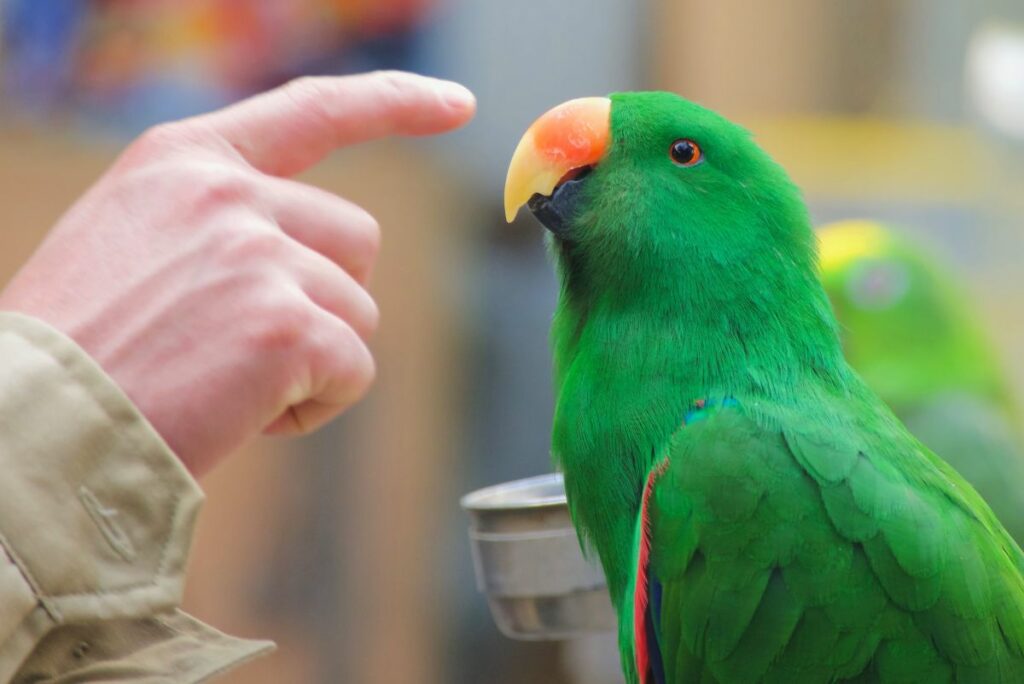Table of Contents
Teaching a bird to talk can be a fun and rewarding experience for both you and your feathered friend. With patience, consistency, and the right techniques, many bird species can learn to mimic words and sounds. This guide outlines seven proven methods on how to teach a bird to talk successfully.

1. Choose the Right Bird Species
Not all bird species are equally adept at mimicking human speech. Some species are naturally more inclined to talk:
- Parrots: Parrots, including African Greys, Budgerigars (Budgies), and Amazon Parrots, are well-known for their talking abilities.
- Cockatiels: Cockatiels can learn to speak a few words or phrases, although they are better at whistling tunes.
- Quaker Parrots: Quaker Parrots (Monk Parakeets) are also good talkers and can learn a variety of words and phrases.
2. Start with a Young Bird
Young birds are typically more adaptable and learn new skills faster than older birds. Starting training when your bird is young can yield better results:
- Early Training: Begin training your bird to talk as soon as it is comfortable in its new environment and bonded with you.
- Patience: Be patient and consistent, as young birds may take some time to start mimicking words.
3. Build a Strong Bond
A strong bond between you and your bird is crucial for effective training. Birds are more likely to mimic words from someone they trust and feel comfortable with:
- Spend Time Together: Spend quality time with your bird every day to build trust and strengthen your bond.
- Positive Interaction: Engage in positive interactions, such as gentle petting, playing, and offering treats.
4. Use Repetition and Consistency
Repetition is key when teaching a bird to talk. Consistent training sessions help reinforce the words you want your bird to learn:
- Frequent Sessions: Conduct short, frequent training sessions (5-10 minutes each) several times a day.
- Repeat Words: Consistently repeat the same words or phrases you want your bird to learn. Start with simple words like “hello,” “goodbye,” or your bird’s name.
5. Use Clear and Enthusiastic Speech
How you say the words is just as important as what you say. Clear, enthusiastic speech grabs your bird’s attention and makes it easier for them to mimic:
- Enunciate Clearly: Speak clearly and slowly, emphasizing each syllable of the word.
- Positive Tone: Use a positive and enthusiastic tone to make the learning process enjoyable for your bird.
6. Incorporate Visual and Audio Aids
Visual and audio aids can enhance your bird’s learning experience. These tools provide additional stimuli that can aid in mimicking:
- Mirrors: Place a mirror near your bird’s cage. Seeing their reflection can encourage them to talk as if they are interacting with another bird.
- Recordings: Use recordings of the words or phrases you want your bird to learn. Play these recordings during training sessions and when you are not around.
7. Reward and Reinforce
Positive reinforcement is essential in training any animal. Reward your bird for attempting to mimic words, even if they are not perfect at first:
- Treats: Offer small, healthy treats as a reward for successful attempts at speaking.
- Praise: Give verbal praise and attention to your bird when they make progress in talking.
- Consistency: Be consistent with rewards to reinforce positive behavior and encourage further learning.
Conclusion on How to Teach a Bird to Talk
Teaching a bird to talk requires patience, consistency, and the right techniques. By following these seven proven methods on how to teach a bird to talk, you can help your bird develop the ability to mimic words and sounds. Remember to start with a young bird, build a strong bond, use repetition, speak clearly, incorporate aids, and always reward progress. With time and dedication, your bird will be chatting away in no time. For more tips on bird care and training, visit the ASPCA and Audubon.
FAQs on How to Teach a Bird to Talk
What are the best bird species for talking?
Parrots, including African Greys, Budgerigars (Budgies), and Amazon Parrots, are known for their talking abilities. Cockatiels and Quaker Parrots are also good at mimicking words.
How long does it take to teach a bird to talk?
The time it takes to teach a bird to talk varies depending on the bird’s species, age, and individual aptitude. It can take weeks to months of consistent training for a bird to start mimicking words.
Can older birds learn to talk?
Yes, older birds can learn to talk, although they may take longer to pick up new words compared to younger birds. Patience and consistency are key.
How many words can a bird learn?
Some birds can learn dozens, even hundreds, of words and phrases. The number of words a bird can learn depends on their species and individual capacity for learning.
Why is my bird not talking?
If your bird is not talking, it may be due to a lack of motivation, insufficient training, or stress. Ensure your bird is comfortable, well-bonded with you, and receives consistent training.
Are there any sounds or words to avoid teaching my bird?
Avoid teaching your bird negative or inappropriate words and sounds. Birds can mimic these sounds in inappropriate situations, which can be embarrassing or problematic.











